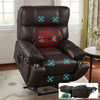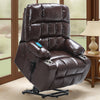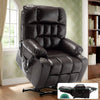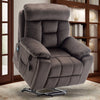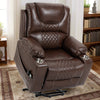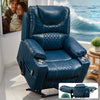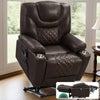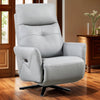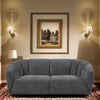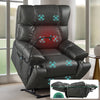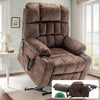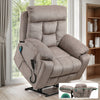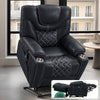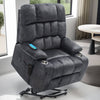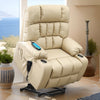Understanding Power Lift Chairs: The Basics and Benefits
What Are Power Lift Chairs?
Power lift chairs are specialized recliners designed to aid mobility. They use motors to tilt and raise, helping users stand up easily. These chairs offer comfort and support for seniors and those with limited mobility.

Key features include:
- Adjustable positions for sitting, reclining, and standing
- Remote control for easy operation
- Various sizes and styles to suit different needs
- Durable materials for long-term use
Power lift chairs blend into home decor while providing essential support. They're ideal for those who struggle with traditional chairs. The lifting mechanism reduces strain on joints and muscles during transitions.
Key Benefits of Using Power Lift Chairs for the Elderly
Power lift chairs offer numerous advantages for older adults. They promote independence and improve quality of life. Here are some key benefits:
- Increased mobility: Helps users stand up and sit down safely
- Reduced fall risk: Provides stable support during transitions
- Improved circulation: Multiple positions aid blood flow
- Pain relief: Adjustable settings can ease joint and muscle pain
- Better sleep: Comfortable recline positions for napping or sleeping
- Enhanced independence: Allows seniors to move without assistance
- Stress reduction: Eliminates anxiety about getting stuck in chairs
These chairs can significantly improve daily life for seniors. They offer both comfort and practical support. Many users report feeling more confident and self-reliant after getting a power lift chair.
Assessing the Need for Power Lift Chairs in Nursing Homes and Hospitals
Nursing homes and hospitals often benefit from power lift chairs. They can enhance patient care and staff efficiency. Here's why they're valuable in these settings:
- Patient comfort: Provides adjustable seating for various conditions
- Staff safety: Reduces risk of injury from lifting patients
- Versatility: Serves multiple purposes, from lounging to sleeping
- Space-saving: Can replace multiple pieces of furniture
- Infection control: Easy-to-clean materials for hygiene standards
When assessing need, consider patient mobility levels and staff workload. Look at space constraints and budget. Many facilities find power lift chairs to be cost-effective long-term investments.
Comparing Elderly Chair Lifts: Features and Functions
The Primary Functions of Elderly Chair Lifts
Elderly chair lifts serve a specific purpose in mobility assistance. They focus on vertical movement, usually along stairs. Key functions include:

- Safe stair navigation: Allows users to move between floors easily
- Customizable tracks: Can be fitted to various staircase designs
- Foldable seats: Save space when not in use
- Safety features: Seatbelts, obstacle sensors, and emergency stops
- Remote control: Easy operation for users and caregivers
- Battery backup: Ensures function during power outages
These lifts are crucial for maintaining independence in multi-level homes. They provide a safe alternative to navigating stairs. This can prevent falls and injuries among elderly users.
Technical Differences Between Power Lift Chairs and Elderly Chair Lifts
While both aid mobility, power lift chairs and elderly chair lifts have distinct features:
Power Lift Chairs:
- Stationary furniture piece
- Multiple reclining positions
- Helps with sitting and standing
- Suitable for various living spaces
Elderly Chair Lifts:
- Moves along a fixed track
- Primarily for stair navigation
- Focuses on vertical transport
- Requires installation on staircases
Power lift chairs offer more versatility in daily use. Chair lifts are specialized for overcoming vertical barriers. The choice depends on specific mobility needs and home layout.
How Elderly Chair Lifts Support the Mobility of the Elderly
Elderly chair lifts play a crucial role in maintaining independence. They allow seniors to access all areas of their homes safely. Benefits include:
- Preserving home value: Avoid costly home modifications
- Extending aging in place: Stay in familiar surroundings longer
- Reducing caregiver strain: Less physical assistance needed
- Preventing accidents: Minimize risks associated with stairs
- Boosting confidence: Seniors feel more secure in their movements
These lifts can significantly improve quality of life. They enable seniors to maintain routines and social connections. This technology supports both physical and emotional well-being.
Selecting the Right Option: Considerations and Best Practices
Evaluating the Cost and ROI of Power Lift Chairs vs. Elderly Chair Lifts
When choosing between power lift chairs and elderly chair lifts, consider both cost and return on investment (ROI). Here's a breakdown:

Power Lift Chairs:
- Initial cost: Generally lower than chair lifts
- Installation: No professional installation required
- Maintenance: Minimal, mostly cleaning and occasional service
- Versatility: Serves multiple purposes daily
Elderly Chair Lifts:
- Initial cost: Higher due to custom installation
- Installation: Professional installation necessary
- Maintenance: Regular checks and potential track adjustments
- Specificity: Solves a particular mobility challenge
ROI factors include improved safety, reduced caregiver needs, and extended independence. Consider long-term benefits against upfront costs. Often, the investment pays off in prevented injuries and enhanced quality of life.
Safety and Ergonomic Features: What to Look for in Lift Chairs for the Elderly
When selecting lift chairs for the elderly, prioritize safety and ergonomics. Key features to consider include:
- Stable base: Ensures chair doesn't tip during lift
- Smooth lift mechanism: Gentle, steady movement
- Easy-to-use controls: Large buttons, simple remote design
- Backup battery: Ensures function during power outages
- Pressure relief cushions: Prevents pressure sores
- Adjustable headrest and lumbar support: Customizable comfort
- Non-slip upholstery: Prevents sliding during use
- Weight capacity: Suitable for the user's size
- Emergency stop feature: Quick halt if needed
Look for chairs that meet or exceed industry safety standards. Ergonomic design should support proper posture and comfort for extended use. Always test chairs before purchase if possible.
Implementing Lift Chairs in Elderly Care Facilities: Regulations and Standards
Implementing lift chairs in care facilities requires adherence to regulations. Key considerations include:
- Compliance with ADA guidelines for accessibility
- Meeting fire safety standards for upholstery and electronics
- Regular maintenance and inspection protocols
- Staff training on proper use and safety procedures
- Documentation of chair usage and any incidents
- Integration with facility emergency plans
Facilities should consult local health department guidelines. They may need to update policies for lift chair use. Regular reviews ensure ongoing compliance and optimal resident safety.
When choosing between power lift chairs and elderly chair lifts, assess individual needs carefully. Consider home layout, mobility requirements, and long-term goals. Both options can significantly enhance senior independence and safety.








